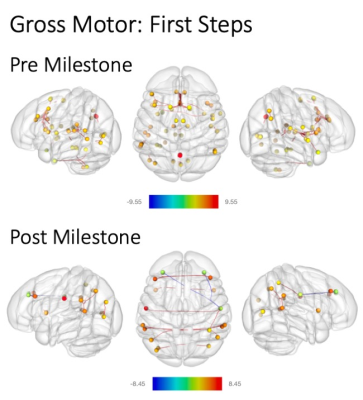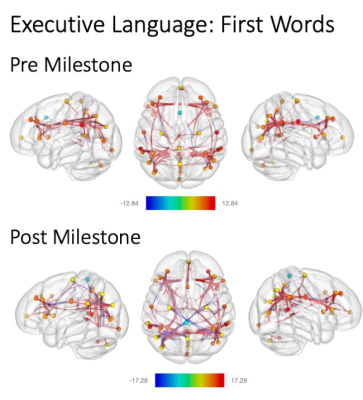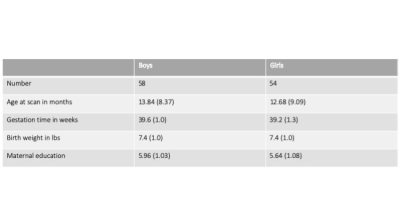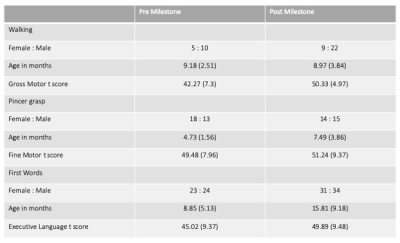4635
Functional Correlates to Achieving Early Motor and Language Milestones1Warren Alpert Medical School, Brown University, Providence, RI, United States, 2Advanced Baby Imaging Lab, Hasbro Children's Hospital, Providence, RI, United States, 3Maternal, Newborn, and Child Health Discovery & Tools, Bill & Melinda Gates Foundation, Seattle, WA, United States
Synopsis
Developmental milestones are essential for a child’s development, with early milestones building a stepping-stone for more complex skills later. In this study, we investigate resting state functional connectivity (fc) before and after major developmental milestones (walking, pincer grasp, first words) were reached in a large cohort of typically developing children (3 to 30 months). Reaching a milestone showed a different fc pattern across all skill domains. Opposite to more complex skills where fc strengthened with skill advancement, walking recruited fewer fc networks when the milestone was reached, possibly underlining the importance of automaticity and complexity demand for the milestone achieved.
Introduction
Reaching their first developmental milestones is an essential step in a child’s development. Being able to walk their first steps or fine grasp pieces of food set the basis for mastering more complex cognitive tasks, and in turn prepare the brain for more complex information processing and organization. They occur in tandem with dynamic changes of brain growth and functional networks1 and functional MRI networks at rest (rsFMRI) have been observed emerging and specializing already in infancy2, possibly paralleling such skill development. While milestone acquisition does not always follow a strict pattern, early gross motor milestones tend to precede fine motor ones, which in turn are followed by more complex cognitive skill development, such as language acquisition. There can be significant individual differences in the ages at which children achieve these milestones and some, such as crawling, may be skipped altogether. However, delays in achievement can be early warning signs for a variation of neurological and psychiatric disorders, including cerebral palsy, autism, and dyslexia3; while early milestone achievement can be indicative of improved later cognitive outcomes4.However, little is known about the development of these functional networks with increasing early milestone abilities during infancy and early childhood1. In order to address this lack in knowledge, we investigated rsfMRI network connectivity before and after three main developmental milestones were reached (walking first steps independently, pincer grasp, first word-gesture combination; all assessed by standardized clinical developmental scores) in a large cross-sectional cohort of typically developing children from 3 to 30 months of age.Methods
rsFMRI data and structural scans were acquired for 112 children on a 3T Siemens Trio scanner with the following parameters: TE = 34ms, TR = 2.5s, voxel resolution: 3x3x3.6mm3, 32 slices. All children included in the study were matched for age, biological sex, gestation time, birth weight, and maternal socio-economic status removing other potential confounding influences (Table 1). For the three milestone, all participants were matched as closely as possible on biological sex, age at scan and individual scores (Table 2). Children with any major neurological disorders were excluded from the study. rsfMRI data were first preprocessed (realignment, centering, motion correction, noise removal, scrubbing) with the CONN fMRI toolbox5 on MATLAB and registered to our child study template using FSL FLIRT6 and ANTS7. The CONN fMRI toolbox was used to extract fc values and perform ROI-to-ROI network connectivity analyses before and after a milestone was reached. Nuisance covariates and realignment parameter noises were reduced using CompCor8, and fMRI data were band-pass filtered (0.008 < f < 0.09HZ). All analyses were corrected for gestational adjusted age and biological sex, and statistical significance was defined as p≤.05 FDR seed-level corrected for multiple comparisons.From the Mullen Scales of Early Learning9, a standardised and population normed tool, the following milestone (MSt) and pre milestone (pMSt) raw scores for gross motor, fine motor, and expressive language were selected to describe three major milestones: walking (pMSt: “Gets from sitting to hands and knees”, “Walks with one hand held”, “Stands alone for 1-2 seconds”), pincer grasp (pMSt: “Reaches for and grasps block”, “Refined grasp/ thumb position while sitting”) and first word-gesture combination (pMSt: “Smiles and makes happy sounds”, “Vocalizes two-syllable sounds (such as “dad” or “baba”)”, “Jabbers with inflection”, “Combines jargon/ gestures”).Results
Across all skill domains, reaching a milestone showed a different fc pattern. While walking recruited fewer fc networks when the milestone was reached (Figure 1), the opposite was observed for more the more demanding skills pincer grasp and combining first words with gestures, where fc strengthened with skill advancement within and across networks (Figures 2, 3). Additionally, the same network patterns were involved in more complex skills, with the highest recruitment of fc networks when the most complex skill had been mastered (Figure 3).Discussion
In this study, we compared brain-behavior correlations before and after a developmental milestone had been reached. Overall, while large-scale networks were preserved across development, their network connectivity increased with skill complexity (Figures 1-3). Specifically, the same network patterns were involved in more complex skills (Figures 2, 3), but increasing fc recruitment with higher skill demand. This parallels previous findings of age-dependent rsfMRI brain-behavior investigations of early complex skill acquisition, such as language development2. While both pincer grasp and combining first words with gestures are skills demanding the interaction of a multitude of functions, they are subject to constant refining and often require direct attention in order to perfect the skill. In contrast, gross motor abilities such as being able to walk focus on automaticity, to enable us to walk while talking or eating a piece of food. This could be reflected in the reduction of fc network recruitment we documented after the milestone was reached (Figure 1). As a result, we propose that the increase in connectivity strength across and within networks for more complex skills prepares the brain for more complex information processing and organization needed to reach developmental milestones. While our findings need to be recreated longitudinally, they could be the first step for detecting early deviation of milestone achievement including early signs of neurodevelopmental disorders, such as autism and developmental coordination disorder.Acknowledgements
We would like to thank the National Institutes of Health (UH3 ODD023313 and R01 MH087510) and the Bill and Melinda Gates Foundation (OPP11002016) for their continuous support of this work.References
1. Marrus, N., et al. (2018). Walking, gross motor development, and brain functional connectivity in infants and toddlers. Cereb Cortex, 28(2), 750-763. 2. Perani, D., Saccuman, M. C., Scifo, P., Anwander, A., Spada, D., Baldly, C., Poloniato, A., Lohmann, G., Friedrich, A. D. (2011). Neural language networks at birth. Proc Natl Acad Sci USA, 108(38), 16056-16061. 3. Dosman, C. F., Andrews, D., Goulden, K. J. (2012). Evidence-based milestone ages as a framework for developmental surveillance. Paediatr Child Health, 17(10), 561-568. 4. Funk, J. B., Ruppert, E. S., Jurs, S. (1982). Assessing the predictive validity of developmental milestones. J Dev Behav Pediatr, 3(3), 143-145. 5. Whitfield-Gabrieli and Nieto-Castanon (2012). Conn: a functional connectivity toolbox for correlated and anticorrelated brain networks. Brain Connectivity, 2(3),125–141. 6. Smith et al. (2014). Advances in functional and structural MR image analysis and implementation as FSL. NeuroImage, 23(1):S208-219. 7. Avants et al. (2014). The insight ToolKit image registration framework. Front. Neuroinformatics, 28;8:44. 8. Behzadi, Y., Restom, K., Liau, J., Liu, T. T. A component based noise correction method (CompCor) for BOLD and perfusion based MRI. (2007). NeuroImage, 37(1), 90-101. 9. Mullen, E. M. (1995). Mullen scales of early learning. AGS; Circle Pines, MN.
Figures




